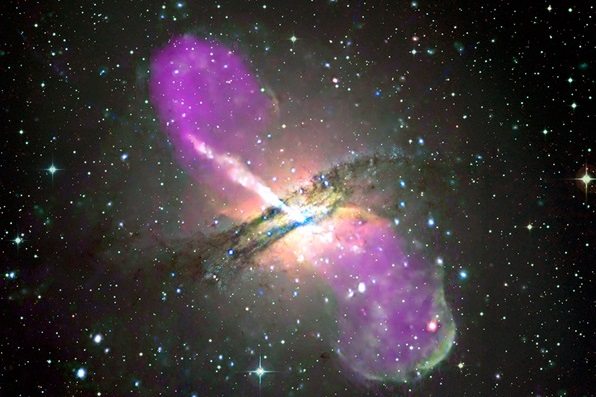
Plasma or dark matter? – local scientists in HESS group confirm breakthrough discovery

Do we live in a dark matter universe or do we live in a plasma universe? This debate has kept scientists both occupied and divided for the better part of fifty years, yet to this date there is no agreement.
This week, a group of space scientist of which some are based in Namibia, announced that they have made an important discovery that indicates plasma originates from the blackhole cores of certain galaxies. This hypothesis was first formulated by NASA scientists in 2015.
Dark matter proponents readily admit that they are still looking for it, but that it must not be discarded as a plausible theory for the vast distances of seemingly nothingness in space, yet full of observable energy.
Plasma theorists on the other hand, say their model accounts for high-energy bursts of gamma rays, detected just about everywhere in space. It furthermore explains the presence and effect of strong as well as weak magnetic fields, which have also been observed empirically. They say, Plasma, also known as the fourth state of matter after solid, liquid and gas, is what fills space across the entire universe.
Helping scientists unravel the wonders of deep space, is the so-called H.E.S.S. telescope on the Gamsberg in Namibia’s Khomas Hochland. H.E.S.S. is a system of Imaging Atmospheric Cherenkov Telescopes that investigates cosmic gamma rays in the energy range from 10s of GeV to 10s of TeV. The name H.E.S.S. stands for High Energy Stereoscopic System, and is also intended to pay homage to Victor Hess, the 1936 Physics Nobel laureate who discovered cosmic radiation.
The week, the H.E.S.S. local team under the leadership of Dr Michael Backes at the University of Namibia, announced that they have discovered that so-called radio galaxies, apart from their visible disc shape, emit two plumes of high-energy gamma rays, away from the disc’s core on either side along the pivotal axis.
“The H.E.S.S. collaboration publishes the first detection of spatially extended VHE gamma-ray emission from an object outside of our own galaxy. The discovery ‘Quasar jets are particle accelerators thousands of light-years long’ will appear in Nature, on Thursday, 18 June 2020,” stated Dr Backes.
“Using the H.E.S.S.1 observatory in Namibia, an international astrophysics collaboration observed a radio galaxy (a galaxy that is highly luminous when observed at radio wavelengths) for over 200 hours at unparalleled resolution. As the nearest radio galaxy to Earth, Centaurus A is favourable to scientists for such a study, enabling them to identify the region emitting the very high-energy radiation while studying the trajectory of the plasma jets. They were able to show that the gamma-ray source extends over a distance of several thousand light-years. This extended emission indicates that particle acceleration does not take place solely in the vicinity of the black hole but also along the entire length of the plasma jets. Based on these new results, it is now believed that the particles are re-accelerated by stochastic processes along the jet. The discovery suggests that many radio galaxies with extended jets accelerate electrons to extreme energies and might emit gamma rays, possibly explaining the origins of a substantial fraction of the diffuse extragalactic gamma background radiation,” stated the H.E.S.S. group.
The work was carried out as part of the H.E.S.S. collaboration, involving in particular the CNRS and CEA in France, and the Max Planck Society and a group of research institutions and universities in Germany, along with universities from South Africa and the University of Namibia. Worldwide, the H.E.S.S. group comprises more than 200 scientists from 13 countries.
The scientists continued: “Over the past few years, scientists have observed the Universe using gamma rays, which are very high-energy photons. Gamma rays, which form part of the cosmic rays that constantly bombard the Earth, originate from regions of the Universe where particles are accelerated to huge energies unattainable in human-built accelerators. Gamma rays are emitted by a wide range of cosmic objects, such as quasars, which are active galaxies with a highly energetic nucleus. The intensity of the radiation emitted from these systems can vary over very short timescales of down to one minute. Scientists therefore believed that the source of this radiation was very small and located in the vicinity of a super-massive black hole, which can have a mass several billion times that of the Sun’s. The black hole is thought to gobble up the matter spiralling down into it and eject a small part of it in the form of large jets of plasma, at relativistic speeds, close to the speed of light, thus contributing to the redistribution of matter throughout the Universe.”
“These findings provide important new insights into cosmic gamma-ray emitters, and in particular about the role of radio galaxies as highly efficient relativistic electron accelerators. Due to their large number, it would appear that radio galaxies collectively make a highly significant contribution to the redistribution of energy in the intergalactic medium.”

Caption: Combining X-ray, radio, and visible-light energy, NASA scientists revealed in 2015 that Centaurus A emits massive lobes of high-energy particles (purple areas) extending outward from the black hole at the galaxy’s centre. (Image by NASA, NSF and ESO)










































